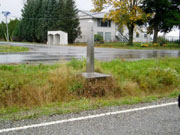VOA标准英语2011--US Weighs Fencing Parts of Shared Canadian Border(在线收听)
US Weighs Fencing Parts of Shared Canadian Border
The United States and Canada share the longest unfortified border in the world. In the border town of Blaine, Washington, a shallow ditch and some warning signs are all that separate U.S. territory from Canada. But that could be about to change.
A study on possible security enhancements for the Department of Homeland Security raises the idea of fencing short portions of the northern border. The environmental review, conducted by the U.S. Customs and Border Protection Agency, also looks at other possible upgrades including putting in patrol roads, short-range radar, more cameras and aerial drones.
But it is the idea of a fence that's really catching the locals' attention.
"It is a disappointing development to think that, after all these many years of being good neighbors, one side or the other might think it necessary now to build a fence," says British Columbia legislator Barry Penner, who represents a district along the border.
 |
| A ditch and short obelisks are all that mark the US-Canada border in northern Whatcom County in Washington state. |
U.S. Customs and Border Protection planner Don Beckham says the agency has no intention of building a fence similar to the steel curtain erected along parts of the U.S. border with Mexico.
"We do discuss fencing, but it would be at very specific locations like fencing on either side of a small, remote port of entry to keep people literally from driving through a field to avoid the port of entry," Beckham says.
Beckham believes it would be unrealistic to try to deter illegal crossings by fencing the entire 6,500-kilometer-long U.S.- Canada border. His team favors a flexible approach which uses a broad array of possible security measures.
"We are looking forward five-to-seven years, understanding that the security threat is not static," he says. "It is constantly changing and Customs and Border Protection needs to change the responses to meet the threat."
| Warning signs like this one are posted along the US-Canada border. |
U.S. Customs and Border Protection is listening to public comments and won't make any decisions until next year, at the earliest, according to Beckham.
Bellingham, Washington, resident Caroline Correa came to a public meeting with concerns about aerial drone surveillance and how border fencing might block wildlife migration.
"But it seemed to be minimal, if I am hearing correctly," she says. "That is a comfort level and we would have to make certain that they hold their word."
Vancouver Sun newspaper columnist Vaughn Palmer finds it ironic the discussion of fencing came up just as the Canadian government is deep in talks with the Obama Administration about a joint North American security pact. The idea there is to tighten controls around the perimeter of the two countries, allowing freer mobility across the shared border.
"Since 9/11, that cross-border relationship has changed in any number of ways," Palmer says. "We are going to be struggling to reconcile the security concerns in the United States with the trade and tourism interests between the two countries."
But that's a delicate dance which could take a while to achieve.